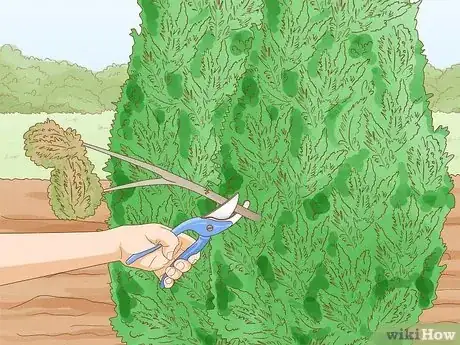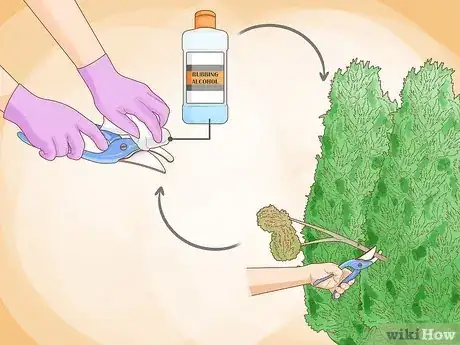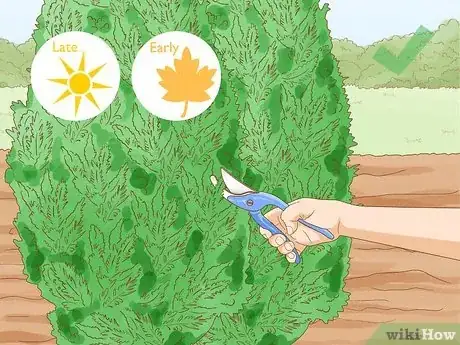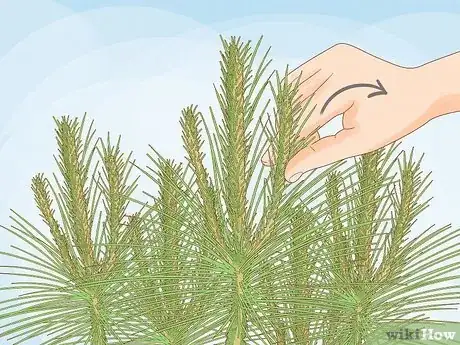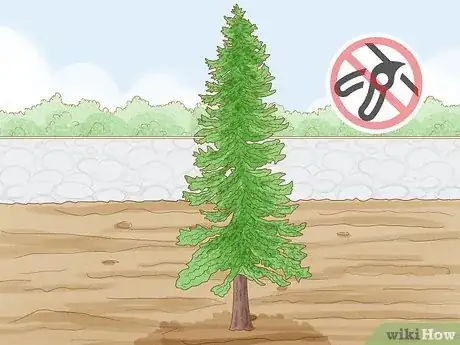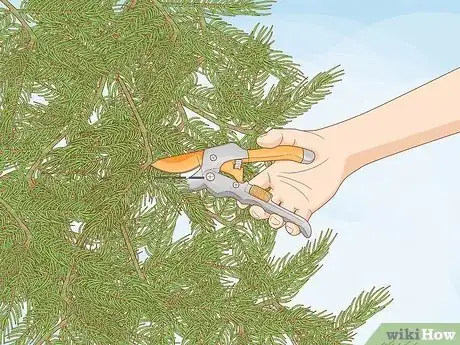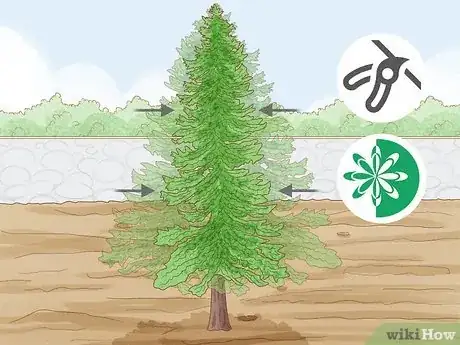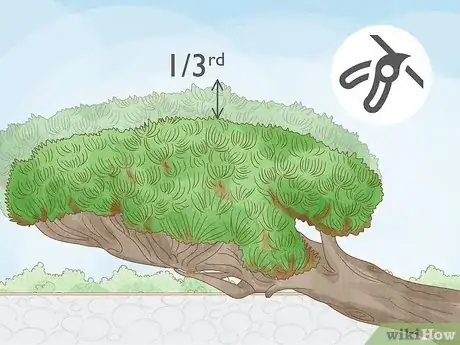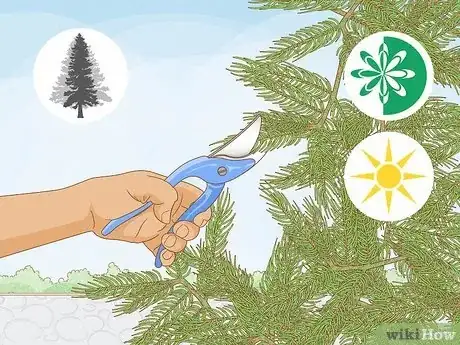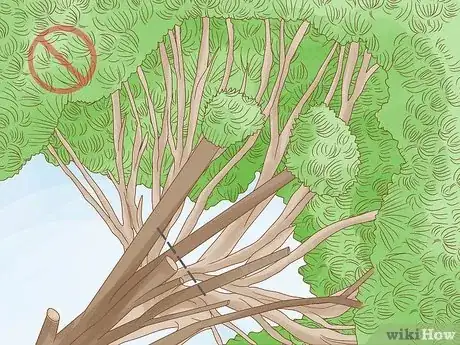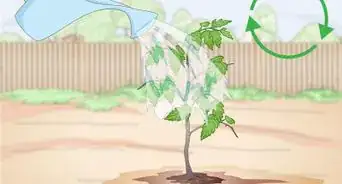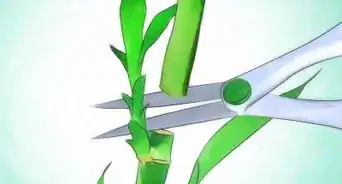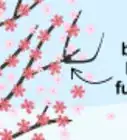This article was co-authored by Lauren Kurtz and by wikiHow staff writer, Christopher M. Osborne, PhD. Lauren Kurtz is a Naturalist and Horticultural Specialist. Lauren has worked for Aurora, Colorado managing the Water-Wise Garden at Aurora Municipal Center for the Water Conservation Department. She earned a BA in Environmental and Sustainability Studies from Western Michigan University in 2014.
This article has been viewed 28,540 times.
While there are many different types of evergreen trees, they can all be generally divided into 2 categories: branching in whirled pines, spruces and firs, and random branching junipers, cedar, yew, hemlock, and arborvitae. There are some common pruning measures you should take no matter the type of evergreen you’re dealing with, but there are also distinctive methods to use based on the tree’s habitat. In most cases, though, except for when removing dead, diseased, or damaged areas, pruning is more of a choice than a necessity for evergreens. Pruning too often can lead to increased susceptibility to diseases and bare spots.
Steps
Pruning for Health (General Evergreen Care)
-
1Cut away dead, diseased, or damaged branches promptly. Pruning evergreens for shape or size should be done seasonally, typically during the dormant period or just before the major growth period. However, if you see a branch that is broken, has no foliage, or appears diseased, you can and should remove it right away, no matter the season.[1]
- Contact a local agricultural extension office, a tree nursery, or an arborist for information on evergreen diseases to look out for in your area.
-
2Sanitize your pruners before and during trimmings. Before and after using your pruners to snip away at evergreen branches, you should wipe them down with a rag moistened with rubbing alcohol. This will remove dirt and sap, and also sanitize them so that you don’t inadvertently transfer any evergreen diseases.[2]
- To be extra safe, also wipe down your pruners when moving from one tree to the next.
- When you’re cutting branches that may be diseased, you should wipe down your pruners after every snip.
Advertisement -
3Sanitize any other tools you use in the same fashion. In most cases, a good pair of loppers or hand pruners will be all you need to prune evergreens. However, you may also want to use a hand saw (for branches over 1 in (2.5 cm) thick), or handheld hedge clippers for shearing. If so, clean them with rubbing alcohol in the same manner as your pruners.[3]
- Always sanitize tools before and after using them, whenever you switch trees/plants, or after you cut any part of a plant that may be diseased.
-
4Leave the “branch collar” behind when you remove a branch. At the point where a branch emerges from a trunk or thicker limb, you’ll see a slightly thicker ring known as the branch collar. Instead of cutting the branch completely flush to the trunk or limb, leave this small collar behind when pruning.[4]
- Doing so will cause less damage to the trunk and make it less susceptible to diseases.
-
5Remove thick branches by making 3 separate cuts. If you’re pruning a branch that’s at least 1 in (2.5 cm) thick, trying to snip or cut it at the collar may cause tears in the bark and damage to the trunk or limb. Instead, make 3 cuts:[5]
- Snip or saw the bottom half of the branch, about 12 in (30 cm) out from the collar.
- Snip or saw the top half of the branch, about 1 in (2.5 cm) further out from the first cut. This will cause the branch to snap between the cuts and break off.
- Cut off the remaining 12 inches (30 cm) of branch at the collar. This will reduce the weight of the branch significantly, so the bark will be less likely to peel or tear.
-
6Train a new “leader” if the current one is damaged. Most types of evergreen trees have a branch known as the leader that extends vertically upwards—this is the branch where you’d place the star on a Christmas tree, for instance. If the leader becomes broken or damaged, you can train a nearby branch to take its place:
- If possible, trim the damaged leader to about 2 inches (5.1 cm) above its lowest side shoot (i.e, smaller branch that extends out from the leader).
- Locate a healthy branch near the leader, bend it upward, and tie it to the old leader and trunk with rope to keep it vertical. If necessary, create a splint with a scrap of wood and tie it in place.
- Remove the rope or splint after a year and see if the branch holds its vertical position as the new leader. If not, tie it up for another year.
-
7Limit your pruning during the late summer and early fall. If you prune an evergreen late in the growing season, you might inadvertently spur new growth just as the typical dormant season begins. Especially in colder climates, this fragile new growth will not survive, and its death may cause more widespread damage to the evergreen tree.[6]
- Seasonal pruning only involves trimming for size or shape, though. You can remove dead, diseased, or damaged branches at any time.
- In most cases, spring—and often early spring—is the best time to prune evergreens. Late fall pruning is also usually OK, and there is often a period in midsummer when evergreens go semi-dormant—you can also do some pruning then.
Pruning Pines
-
1Pinch back “candles” by hand in spring. The needles of pine trees grow in bunches off of thin branches known as candles. To limit outward growth and make the internal foliage denser, you can trim these candles by half (or less) by pinching them with your fingernails.[7]
- During the spring, the candles should be tender and small enough for you to prune with your fingers. Don’t use pruners unless you have to, as they will cut through the developing needles and therefore may cause brown tips at the end of the branch.
-
2Don’t cut into the woody stems of healthy branches. Especially when dealing with pines, it’s best to either prune off entire branches or just the ends of the candles. New growth rarely occurs from the ends of half-cut pine branches, so you’ll end up with unsightly bare spots.[8]
- Dead, damaged, or diseased branches should be removed in their entirety, though.
-
3Leave pines alone for the most part. Pine trees typically develop a pleasing, natural shape all on their own and rarely need your assistance. If space isn’t an issue and there isn’t disease or damage to deal with, it’s easiest and healthiest to just let them go without pruning.
- Prune them for width only if they’re tightly bunched with other trees or are encroaching on a structure such as your house. It’s best not to try to prune them for height.
Cutting Back Firs and Spruces
-
1Prune firs and spruces mainly to control width. Unlike pines, both firs and spruces grow needles all along the lengths of their outer branches. Like pines, though, these evergreens are best left unpruned under most circumstances.
- You can prune them annually to control width if bunching with other trees is a problem, or if they’re too close to a structure.
- Attempting to prune for height is not recommended for the average homeowner.
-
2Cut most or all the way to back to lateral branches in spring. To slow the expansion (especially widthwise) of a spruce or fir, you can trim back the new unbranched tips (new growth emerging from an existing lateral branch) by about two-thirds. To keep outward growth under even firmer control, you can cut off this new growth all the way back to the lateral branches.[9]
- It’s best to do this pruning in early or mid-spring, when the unbranched tips are just emerging.
-
3Shear for shaping in late spring. If you really want to control the overall shape of a fir or spruce you can shear it—that is, cut off the ends of many branches to achieve a desired shape. It’s best to shear in late spring, once the new growth has emerged more fully and is less fragile.[10]
- Only try to make minor shape adjustments through shearing, though, as opposed to major reshaping of a fir or spruce. Otherwise, you’ll likely end up with bare or dead spots.
- You can use handheld hedge clippers for shearing, but make sure to sanitize them with rubbing alcohol before and after using them.
Shaping Random Branch Evergreens
-
1Remove up to two-thirds of new growth to control their size. Random branch evergreens like junipers, arborvitae, yews, and hemlocks usually sprout new branches with flat needles during the spring. You can prune them for size once or twice annually, but you should leave behind at least one-third of new growth during each pruning.
- The needles on areas of new growth tend to be softer and lighter in color.
- Leaving some new growth behind is beneficial for the health of the evergreen.
-
2Prune or shear them for shape in spring and summer. As the name indicates, random branch evergreens grow in less naturally-structured shapes than do pines, spruces, or firs. This means you may want to be a bit more aggressive in shaping them to suit your aesthetic preferences.[11]
- You can shear random branch evergreens several (e.g., 2-3) times during the spring and summer, if you wish.
- However, as you shear and prune for shape, make sure to leave behind some of the new growth.
- Random branch evergreens don’t need to be shaped, and will do just fine if you let them grow naturally.
-
3Don’t prune them back to the “dead zone” in the middle. Most random branch evergreens develop an area in the center where there are no needles, due to the lack of sunlight. If you prune back to this “dead zone,” new growth will not occur there and you’ll end up with a bare patch.[12]
- When pruning for size or shape, work with what you have instead of trying to force your evergreen into a specific look. For instance, try to find the beauty in the “randomness” of your upright juniper!
Community Q&A
-
QuestionMy evergreen has dead branches. When should I cut them?
 Community AnswerIf you have any dead, diseased or broken branches, feel free to remove them whenever.
Community AnswerIf you have any dead, diseased or broken branches, feel free to remove them whenever.
Things You'll Need
- Handheld pruners
- Rubbing alcohol
- Cleaning cloth
- Handheld hedge clippers (for shearing)
- Hand saw (for larger branches)
References
- ↑ http://www.mortonarb.org/trees-plants/tree-and-plant-advice/horticulture-care/pruning-evergreens
- ↑ https://pubs.ext.vt.edu/430/430-457/430-457.html
- ↑ https://pubs.ext.vt.edu/430/430-457/430-457.html
- ↑ https://pubs.ext.vt.edu/430/430-457/430-457.html
- ↑ https://pubs.ext.vt.edu/430/430-457/430-457.html
- ↑ https://pubs.ext.vt.edu/430/430-457/430-457.html
- ↑ https://pubs.ext.vt.edu/430/430-457/430-457.html
- ↑ http://www.mortonarb.org/trees-plants/tree-and-plant-advice/horticulture-care/pruning-evergreens
- ↑ http://www.mortonarb.org/trees-plants/tree-and-plant-advice/horticulture-care/pruning-evergreens
